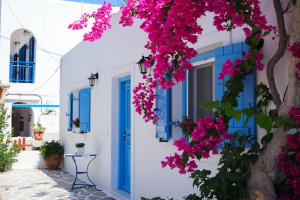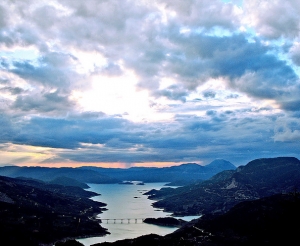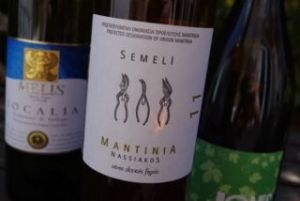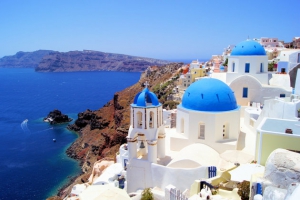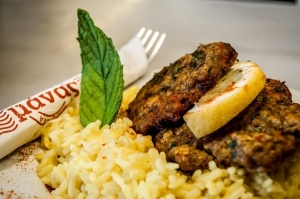Semeli was founded in 1979 - the wines have been well received both on the home market and abroad and have won many international awards. The company is committed to developing local wines that are based on local products that are affordable. It also wants to create more wine tourism to the country, and offers tours around their wineries in Nemea and Mantinea in the Peloponnese.
XpatAthens
A Guide To Greek Herbal Teas
Greek Mountain Tea
No Greek household is ever short of Greek mountain tea or as we say in Greek, tsai tou vounou (τσάι του βουνού). It is made using the dried leaves and flowers of Sideritis plant (ironwort), which grows mainly in Greece, Albania and Bulgaria.
The name is a good fit for the tea since the plant is found on rocky slopes at high altitudes. It’s common for the locals to go out in the countryside and gather it rather than grow it in the fields or their gardens. The leaves and flowers are then left to dry and store in airtight containers until it’s time for brewing.
The tea contains high levels of antioxidants and large amounts of essential oils, flavonoids, sterols, and other phytonutrients. It is mainly used to combat colds, respiratory problems and indigestion, but also has soothing effects.
Greek mountain tea comes as loose leaves rather than tea bags and can be found in grocery stores and shops that sell herbs and spices. If you find yourself in the Greek countryside, you’ll probably come across little agriculture cooperatives that gather and sell local mountain tea, so make sure to buy some.
Faskomilo (Sage)
Faskomilo (φασκόμηλο) grows in Mediterranean climates and its Latin name, salvia, comes from the Latin verb salvare which translates as to save or to cure. Its leaves have a strong smell and they are used both for cooking and for brewing beverages with numerous healing qualities. In ancient times, it was widely used for as an antiseptic on open wounds and can still have a soothing effect if your skin is irritated, but we wouldn’t necessarily recommend for you to replace more modern treatments.
As a beverage, it is often seen as a natural treatment for throat infections, inflammation of the gums, mouth ulcers as well as other small irritations in the area of the mouth. Faskomilo boosts the nervous system, improves memory and revs up blood circulation.
Throumbi (Savory)
Savory or, in Greek, throumbi (θρούμπι) is small bush-like plant with pink, purple or white flowers that blossoms between July and September in Greece and other countries around the Mediterranean Sea. Its therapeutic qualities have been known to the Greeks since ancient times and they have been using it for cooking since then. Nowadays, we know that it helps with indigestion, stomachache, nausea and diarrhoea.
Levanda (Lavender)
We use lavender when storing our clothes to help keep them fresh and moth-free, but did you know that it can also be brewed into a fragrant beverage with countless healing qualities? Lavender grows in abundance in Greece. Its beautiful purple flowers can be dried and then brewed to create a beverage that soothes and relaxes the mind and body. It is supposed to help with head- and tummy aches, and to relieve stress and insomnia. Lavender blooms and gets collected during the summer months.
Herbs And Their Medicinal Qualities
Previous generations, especially in the countryside, used to rely a lot on herbs and their healing or health benefits considering that access to a doctor was more difficult than it is today. Not every village had a doctor and not everyone was able to afford them. As a result, people – especially women – sought to harness the power of different plants and herbs to offer relief from different ailments.
Nowadays, brewing someone some tsai tou vounou or another herbal tea is often the first response when someone is down with a cold or suffering from a tummy ache, but they are secondary to modern medicine, especially when it comes to treating more serious or chronic diseases. Teas are seen mainly as a pleasant alternative to coffee that tastes nice and soothes the mind and body after a stressful day.
To learn how to prepare Greek herbal teas, click here.

Masaresi.com was founded by Maya Cornelissens-Andreadi, who shares her experience about how “to integrate in Greece and feel like a local”. Masaresi = μας αρέσει = we like it! Discover the “real Greece," while delving into all the aspects of Greek life – from modern lifestyle and culture to history, literature, traditions, and many more.
Explore Greece - Read About Greece - Buy Greek - Learn Greek
Why Our Emotional Reactions Are Becoming Less Intense
3. Look into our specific prejudices with a magnifying mirror as they affect our perspective.
4. Work on ways to overcome those prejudices.
Is it easy to do? Not necessarily but it doesn’t have to be hard either. It all depends on how dedicated – and not simply willing – you are to working on bringing about the lasting changes you want to see in your behavior and in your life.
If there’s a topic you’re interested in and would like to learn more about you may contact me via email. For more information about me and my work check the XpatAthens Directory or visit my website. Because this is your life!
Retiring In Greece: A Comprehensive Guide
Obtaining a residence permit starts with a three-month entry visa, known as the "D" type visa, which can be acquired through the Greek consulate in your home country. To obtain such a visa the required documents include:
- Your passport, valid for at least three months after the expiration of the visa
- A biometric passport Photo
- The Application form, filled in English or Greek
- A medical certificate filled out by a licensed doctor
- Proof of medical insurance valid in Greece
- An excerpt from the penal register issued by your country of origin or current residence
Athens Carnival 2025: A Citywide Celebration of Music, Dance, & Tradition
Athens is gearing up for another spectacular carnival season in 2025, bringing together age-old traditions, vibrant parades, and electrifying musical performances. From the grand procession in Syntagma Square to neighborhood festivities filled with laughter and dance, the Greek capital will be brimming with the spirit of Apokries. Whether you’re a local or a visitor, this year's carnival promises unforgettable moments for all. Here’s a detailed look at what’s in store!
Thursday, February 20 – Tsiknopempti (Smoky Thursday)
Kickstarting the festivities, Tsiknopempti is a day dedicated to feasting, music, and merriment:
-
11 AM: The streets of Athens come alive with a Traditional Apokries Parade featuring a reenactment of the Kordelatoi from Naxos. Expect a colorful display from Syntagma Square to Monastiraki.
-
11:30 AM: Enjoy a Philharmonic Orchestra Musical Walk at Varvakios Market, setting the perfect carnival mood.
-
12 PM: A concert by the Athens Municipality Greek Music Workshop will keep spirits high with Greek folk and laïko tunes at Varvakios Market.
-
7 PM & 8:30 PM: As the night falls, Kotzia Square hosts back-to-back live concerts with KogiaMan and Gidiki, blending traditional Greek, Balkan, and Mediterranean melodies.
Saturday, February 22 – Community and Street Festivities
-
11 AM: Experience the magic of a Parade of Carnival Groups winding from Kotzia Square to Monastiraki, where folk reenactments will showcase Greece’s rich cultural heritage.
-
11:30 AM: The little ones can enjoy a Children’s Carnival Party in Dourgouti Park, featuring games, face painting, and balloon artistry.
-
12 PM: Athens’ neighborhoods come alive with multiple Carnival Walks, including a drumming parade by Quilombo in Kypseli and a folk dance party in Mesolongiou Square.
-
1 PM: Music lovers shouldn’t miss the Athens Municipality Big Band Jazz Concert on Dionysiou Areopagitou Pedestrian Street, adding a swing-infused touch to the celebrations.
Sunday, February 23 – Family-Friendly Fun and Cultural Revelry
-
10 AM: Engage in the 14th Treasure Hunt in Mets, a fun and educational adventure through Athens' historical sites.
-
11:30 AM – 2 PM: Zappeion transforms into a carnival wonderland with children’s entertainment, stilt walkers, and circus acts.
-
12 PM: Plaka and Thissio turn into open-air theaters with traditional Apokries performances and the famous gaitanaki ribbon dance.
-
6 PM: A Zakynthian Carnival Walk from the Acropolis Metro to Monastiraki celebrates the Ionian tradition with serenades and folk dances.
Tuesday, February 25 – Satirical Songs and Neighborhood Carnivals
-
10 AM – 1 PM: Kypseli Municipal Market hosts a Children’s Carnival Celebration featuring music and interactive activities.
-
7 PM: The OTE Cultural Centre presents an evening of satirical carnival songs and dances, highlighting Apokries’ playful and humorous side.
Thursday, February 27 – Community Carnival Parades
-
10:30 AM: The neighborhoods of Attiki and Agios Panteleimonas come together for a Carnival Parade, where school groups and cultural collectives showcase their Apokries spirit.
Saturday, March 1 – A Day for the Kids
-
11 AM: Across Athens, parks and squares host Children’s Carnival Celebrations, complete with mascots, games, face painting, and traditional dances.
-
12 PM – 2 PM: Klafthmonos Square stages a lively outdoor performance of “Two Grooms – One Bride”, a theatrical nod to 17th-century Zakynthian carnival traditions.
Sunday, March 2 – The Grand Carnival Parade
-
5 PM: The carnival season reaches its peak with the Grand Carnival Parade from Syntagma to Kotzia Square. Expect stilt walkers, dance performances, a stunning Chinese dragon, and a vibrant street party.
-
7 PM: The night concludes with a Live Concert by Decibel Band in Kotzia Square, delivering an energetic fusion of music and carnival vibes.
Monday, March 3 – Clean Monday (Kathara Deftera)
-
11 AM: Athens embraces the Lenten season with Koulouma at Philopappou Hill, featuring traditional kite flying and folk music.
-
11:30 AM: A Philharmonic Orchestra Musical Walk ensures the carnival ends on a melodious note.
-
11:30 AM: Dance and celebrate one last time with a Traditional Folk Gathering, complete with delicious Lenten treats.
Join the Celebration!
Whether you’re after dazzling parades, cultural traditions, or musical extravaganzas, Athens Carnival 2025 has something for everyone. Mark your calendar, put on your best costume, and immerse yourself in the city's most vibrant festival of the year!
Evrytania – An Ultimate Winter Get-Away
Rugged scenery, endless fir forests and an invigorating climate are among the many assets of the district of Evrytania, at the southern end of the Pindos mountain range. It is associated with images of an ideal winter holiday perhaps more than any other destination in the country: snow-covered mountain slopes, rushing waters, stacks of logs and smoking chimneys. However Evrytania is also pleasant for cool escapes in summer, when city dwellers flock back to their family homes in the villages.
During the Byzantine period the district enjoyed privileges of autonomy and tax exemption. For this reason the northern part of the district was also called “Agrafa” (literally “unwritten”), because the residents were not included in the imperial tax registers.
The wild landscape, which helped keep central authority and aspiring occupiers at a distance, nowadays also offers many options for alternative tourism activities. Skiing at Velouchi and rafting on the rapids of the Acheloos, Trikeriotis and Tavropos rivers have been the sports that have catapulted the district’s largely untapped tourism potential to popularity in the last two decades.
The part of Evrytania which is best known and most popular with tourists lies on the road axis between Karpenisi, the main town, and the historic Monastery of Proussos -- perched like an eagle’s nest atop a precipitous cliff above a gorge. Cameras should be at the ready to capture the highlights of the route, especially Kleidi, the narrowest point of the gorge from where the monastery is first visible.
Karpenisi, a town of less than 10,000 people at 1,000 meters on the slopes of Mt Tymfristos, is the base for most activities in the area. Lying on the route to Proussos are the well-known picturesque villages of Mikro and Megalo Horio and the listed settlement of Koryschades. It was this latter village that hosted the elected National Assembly during the German occupation, on May 7, 1944 and has a Museum of National Resistance.
Fidakia, 17 kilometers from Karpenisi, is one of the most beautiful villages in Evrytania, with a fine view of the Kremasta reservoir. Just outside the scenic village of Klafsi, in the Potamia valley, is the unique 5th- to 6th-century Basilica of Aghios Leonidios, with an exquisite, well-preserved mosaic floor.
The main village of Proussos, at the edge of the tourist zone, is best known for the reportedly miraculous icon of Our Lady of Proussos in the monastery, which attracts thousands of visitors annually and can be congested at weekends, especially Sundays.
An easy hiking route, lasting about two hours, takes walkers from the monastery to Mavri Spilia (“Black Cave”) -- next to a waterfall -- which was used as a hideout by guerrillas in years gone by. The more adventurous can rappel down the cliff face. A second route in the area, beginning from the village of Aniada and lasting about an hour and a half, takes in the slopes of Mt Kaliakouda. Part of it runs alongside the Trikeriotis River before it ends at the Pantavrechi waterfalls.
Aghios Nikolaos, 6 kilometers from Karpenisi, is a charming village known for the most prolonged snow cover in the district and its chestnuts.
A fine route through dense fir forest on the slopes of Mt Oxya is from Karpenisi to the beautiful mountain villages of Krikello and Domnista, if you take a right turn from the road to Lamia going east. As you enter Krikello, at 1,120 meters, you will see five stone fountains gushing the icy waters of Mt Oxya. Domnista has some huge plane trees and an impressive folk museum which also hosts local ancient finds. The village also features a monument to the national resistance, as it was here that resistance leader Aris Velouchiotis proclaimed the armed struggle against the Axis occupiers on June 7, 1942.
Lastly, it is worth seeing the Bridge and Monastery of Tatarna, in a beautiful area near the Kremasta dam. The view of the lake from the bridge, which has won three architectural awards, is superb and the monastery houses a number of precious icons.
Things to See & Activities
Evrytania is replete with sights and historical monuments. Opportunities for mountain sports abound throughout the year: contact Ef Zein (25673 and 695.396808, www.fzein-evryt.gr/), Mountain Action (22940 and 6972.706.177), and Trekking Hellas (25940 and 6972.421.349). Saloon Park (24606), 4 kilometers from Karpenisi, offers horse-riding activities. Eleven kilometers from town at an elevation of 1,800 meters, is the Velouchi skiing center (23506, 21112). Megalo Horio has an interesting folk history museum.
Author: Haris Argyropoulos
Greek Wine Tops World Best List
A Greek winemaker has made it on to one of the world's top 10 wine lists of the year. Semeli Mantinia Nasiakos 2012 wine took out the American press honour for its fruity aroma and for making "every sip cause a smile". The wine itself was described as a "shiny and fruity wine, with aromas of ripe fruits that leave in the mouth the taste of the sun".
The Tradition Of Tsiknopempti
Tsiknopempti is the Thursday during carnival that marks the coming of lent, and the last day that observant Greek Orthodox parishioners eat meat before they begin their 40-day fast.
Tradition has it that on this day everyone prepares and enjoys their favorite meat dishes and typically a cloud of smoke where it is being cooked or barbecued. This gives Tsiknopempti one of its other common names, "Smoke Thursday" or "Smoked Thursday". It is also called "Barbecue Thursday" or "Grilled Thursday" by some. Tsiknopempti is also a popular day for going out to eat and enjoying as many different meats as possible. Be sure to reserve a table ahead of time as restaurants and traditional taverns are typically fully booked!
Meaning of Tsiknopempti
In Greek, Thursday is Pempti (Πέμπτη), meaning the fifth day of the week as Greeks count Sunday as the first day. The word tsikna (Τσίκνα) refers to the smell of cooked meat - however, "Smelly Thursday" has not caught on as a translation.
In English, Mardi Gras means "Fat Tuesday" and so Tsiknopempti is sometimes also called "Fat Thursday" - which is logical as the cooking of all that meat results in vast quantities of fat dribbling down onto the coals.
Typical Tsiknopempti Menu
Meat is king, with the emphasis on grilled meats! Some restaurants and virtually every traditional taverna will put on special menus for Tsiknopempti. By far, the most common item will be some variation of souvlaki - the Greek version of meat on a stick. These are available almost everywhere - walk carefully to avoid banging into an unexpected grill mostly obscured by smoke, sharing the already narrow streets and walkways!
Tsiknopempti Outside Of Greece
An equivalent of Tsiknopempti is also celebrated in Germany and Poland, but there they are adhering to the Western calendar for Easter, so the date differs. Most Eastern Orthodox and Greek Orthodox church calendars will be in alignment for Tsiknopempti and the rest of the Carnival, Lent, and Easter seasons, but there are some exceptions for faith groups adhering to a different variant of the old calendar.
What Travellers Need To Know About Visiting Greece
Manas Kouzina-Kouzina Restaurant In Athens
Address: Aiolou 27
Telephone: 210 325 2335
Email: manaskouzinakouzina@gmail.com
Greek Bank Accounts In The Capital Controls Era
- Cash withdrawals of up to 420 Euros per week or 840 per two-week period may be made.
- Funds may be transferred within the Greek banking system without significant restrictions.
- Funds up to 1,000 Euros per month may be transferred abroad without special permission.
- ATM cards linked to non-Greek bank accounts are restriction-free for cash withdrawals.
To read this article in full, please visit: K.Sirouni Architecture and Property Management




